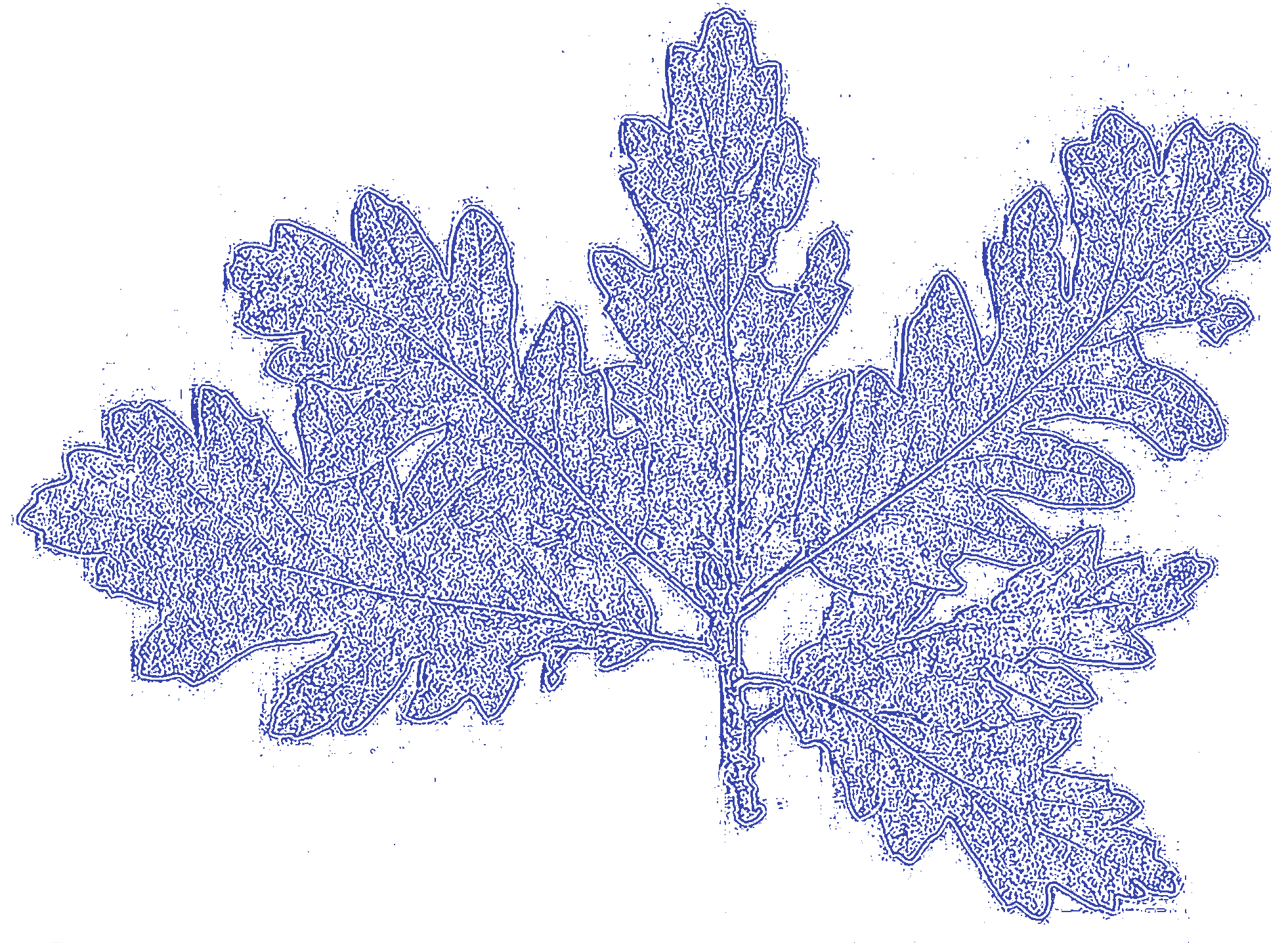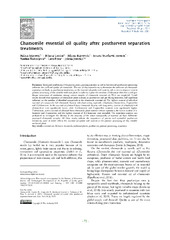Chamomile essential oil quality after postharvest separation treatments
Uticaj tretmana poslezetvene separacije na kvalitet etarskog ulja kamilice
Authors
Aćimović, Milica
Lončar, Biljana

Kiprovski, Biljana

Stanković Jeremić, Jovana

Todosijević, Marina

Pezo, Lato

Jeremić, Jelena
Article (Published version)
Metadata
Show full item recordAbstract
Ecological conditions of the growing areas, growing practices as well as harvest and postharvest processing influence the yield and quality of chamomile. The aim of this research was to determine the influence of chamomile separation methods, as postharvest treatments, on the essential oil quality and content, with a view to improve current primary processing of this valuable medicinal plant. In order to explain the structure of laboratory data that would give deeper assessment of similarities among various samples of chamomile essential oil, PCA was employed. Tested results showed that separation of chamomile plant material, as postharvest and pre-drying treatment, had significant influence on the number of identified compounds in the chamomile essential oil. The highest content of individual essential oil compounds had chamomile flowers with short stems, especially α-bisabolol, chamazulene, Z-spiroether and E-β-farnesene. In the essential oil obtained from chamomile flowers with long... stems, content of α-bisabolol and chamazulene were significantly lower, while E-β-farnesene and Z-spiroether contents were significantly higher. Furthermore, in the essential oil obtained from chamomile plant material without separation, the lowest content of αbisabolol and Z-spiroether, and the highest content of E-β-farnesene were recorded. The correlation analysis was performed to investigate the likeness in the amounts of the active compounds of essential oil from differently processed chamomile samples. All these results indicate the importance of precise and controlled postharvest treatments, since it clearly affects the essential oil quality and content in the primary processing of this valuable medicinal plant.
Ekološki uslovi proizvodnog područja, tehnologija gajenja kao i žetva, ali i posležetveni tretmani značajno utiču na prinos i kvalitet kamilice. Cilj ovog istraživanja je bio da se odredi uticaj metoda separacije, kao posležetvenog tretmana, na kvalitet etarskog ulja, sa ciljem da se unapredi process primarne prerade ove lekovite biljke. Da bi se objasnila struktura laboratorijskih podataka, procenile i sagledale sličnosti i razlike između uzoraka etarskih ulja kamilice dobijenih primenom različitih metoda separacije, korišćena je PCA metoda. Dobijeni rezultati pokazuju da separacija sirovine kamilice kao posležetveni tretman koji prethodi sušenju, ima značajnog uticaja na broj identifikovanih komponenti u etarskom ulju, ali i njihov udeo. Najmanji broj pojedinačnih komponenti u etarskom ulju je imao uzorak cvetnih glavica sa kratkom drškom, pri čemu je zabeležen najveći sadržaj α-bisabolol, hamazulen, Z-spiroeter i E-β-farnesen. U etarskom ulju dobijenom od biljne sirovine sa većim ud...elom stabla kamilice, sadržaj α-bisabolola i hamazulena je bio značajno niži, dok je sadržaj E-β-farnesena i Z-spiroetera bio značajno viši. Dalje, u etarskom ulju dobijenom od bioljnog materijala bez separacije, zabeležen je najniži sadržaj α-bisabolola i Z-spiroetera, i najveći sadržaj E-β-farnesena. Analiza korelacije je izvedena da bi se ispitala sličnost u sadržaju aktivnih komponenti u etarskom ulju dobijenom primenom različitih procesa separacije kamilice. Svi rezultati ukazuju na značaj primene posležetvenih tretmana, jer se jasno vidi njihov uticaj na kvalitet etarskog ulja ove veoma važne lekovite biljke.
Keywords:
Essential oil / Matricaria chamomilla / Medicinal plants / Postharvest / Primary processing / Separation / etarsko ulje / lekovito bilje / posležetvena prerada / primarna prerada / separacijaSource:
Ratarstvo i Povrtarstvo, 2021, 58, 72-78Publisher:
- Novi Sad : Institut za ratarstvo i povrtarstvo
Funding / projects:
- Ministry of Science, Technological Development and Innovation of the Republic of Serbia, institutional funding - 200032 (Institute of Field and Vegetable Crops, Novi Sad) (RS-MESTD-inst-2020-200032)
- Interreg – IPA CBC HUSRB 7190374270059
Collections
Institution/Community
IHTMTY - JOUR AU - Aćimović, Milica AU - Lončar, Biljana AU - Kiprovski, Biljana AU - Stanković Jeremić, Jovana AU - Todosijević, Marina AU - Pezo, Lato AU - Jeremić, Jelena PY - 2021 UR - https://cer.ihtm.bg.ac.rs/handle/123456789/4785 AB - Ecological conditions of the growing areas, growing practices as well as harvest and postharvest processing influence the yield and quality of chamomile. The aim of this research was to determine the influence of chamomile separation methods, as postharvest treatments, on the essential oil quality and content, with a view to improve current primary processing of this valuable medicinal plant. In order to explain the structure of laboratory data that would give deeper assessment of similarities among various samples of chamomile essential oil, PCA was employed. Tested results showed that separation of chamomile plant material, as postharvest and pre-drying treatment, had significant influence on the number of identified compounds in the chamomile essential oil. The highest content of individual essential oil compounds had chamomile flowers with short stems, especially α-bisabolol, chamazulene, Z-spiroether and E-β-farnesene. In the essential oil obtained from chamomile flowers with long stems, content of α-bisabolol and chamazulene were significantly lower, while E-β-farnesene and Z-spiroether contents were significantly higher. Furthermore, in the essential oil obtained from chamomile plant material without separation, the lowest content of αbisabolol and Z-spiroether, and the highest content of E-β-farnesene were recorded. The correlation analysis was performed to investigate the likeness in the amounts of the active compounds of essential oil from differently processed chamomile samples. All these results indicate the importance of precise and controlled postharvest treatments, since it clearly affects the essential oil quality and content in the primary processing of this valuable medicinal plant. AB - Ekološki uslovi proizvodnog područja, tehnologija gajenja kao i žetva, ali i posležetveni tretmani značajno utiču na prinos i kvalitet kamilice. Cilj ovog istraživanja je bio da se odredi uticaj metoda separacije, kao posležetvenog tretmana, na kvalitet etarskog ulja, sa ciljem da se unapredi process primarne prerade ove lekovite biljke. Da bi se objasnila struktura laboratorijskih podataka, procenile i sagledale sličnosti i razlike između uzoraka etarskih ulja kamilice dobijenih primenom različitih metoda separacije, korišćena je PCA metoda. Dobijeni rezultati pokazuju da separacija sirovine kamilice kao posležetveni tretman koji prethodi sušenju, ima značajnog uticaja na broj identifikovanih komponenti u etarskom ulju, ali i njihov udeo. Najmanji broj pojedinačnih komponenti u etarskom ulju je imao uzorak cvetnih glavica sa kratkom drškom, pri čemu je zabeležen najveći sadržaj α-bisabolol, hamazulen, Z-spiroeter i E-β-farnesen. U etarskom ulju dobijenom od biljne sirovine sa većim udelom stabla kamilice, sadržaj α-bisabolola i hamazulena je bio značajno niži, dok je sadržaj E-β-farnesena i Z-spiroetera bio značajno viši. Dalje, u etarskom ulju dobijenom od bioljnog materijala bez separacije, zabeležen je najniži sadržaj α-bisabolola i Z-spiroetera, i najveći sadržaj E-β-farnesena. Analiza korelacije je izvedena da bi se ispitala sličnost u sadržaju aktivnih komponenti u etarskom ulju dobijenom primenom različitih procesa separacije kamilice. Svi rezultati ukazuju na značaj primene posležetvenih tretmana, jer se jasno vidi njihov uticaj na kvalitet etarskog ulja ove veoma važne lekovite biljke. PB - Novi Sad : Institut za ratarstvo i povrtarstvo T2 - Ratarstvo i Povrtarstvo T1 - Chamomile essential oil quality after postharvest separation treatments T1 - Uticaj tretmana poslezetvene separacije na kvalitet etarskog ulja kamilice VL - 58 VL - 2 SP - 72 EP - 78 DO - 10.5937/RATPOV58-33346 ER -
@article{
author = "Aćimović, Milica and Lončar, Biljana and Kiprovski, Biljana and Stanković Jeremić, Jovana and Todosijević, Marina and Pezo, Lato and Jeremić, Jelena",
year = "2021",
abstract = "Ecological conditions of the growing areas, growing practices as well as harvest and postharvest processing influence the yield and quality of chamomile. The aim of this research was to determine the influence of chamomile separation methods, as postharvest treatments, on the essential oil quality and content, with a view to improve current primary processing of this valuable medicinal plant. In order to explain the structure of laboratory data that would give deeper assessment of similarities among various samples of chamomile essential oil, PCA was employed. Tested results showed that separation of chamomile plant material, as postharvest and pre-drying treatment, had significant influence on the number of identified compounds in the chamomile essential oil. The highest content of individual essential oil compounds had chamomile flowers with short stems, especially α-bisabolol, chamazulene, Z-spiroether and E-β-farnesene. In the essential oil obtained from chamomile flowers with long stems, content of α-bisabolol and chamazulene were significantly lower, while E-β-farnesene and Z-spiroether contents were significantly higher. Furthermore, in the essential oil obtained from chamomile plant material without separation, the lowest content of αbisabolol and Z-spiroether, and the highest content of E-β-farnesene were recorded. The correlation analysis was performed to investigate the likeness in the amounts of the active compounds of essential oil from differently processed chamomile samples. All these results indicate the importance of precise and controlled postharvest treatments, since it clearly affects the essential oil quality and content in the primary processing of this valuable medicinal plant., Ekološki uslovi proizvodnog područja, tehnologija gajenja kao i žetva, ali i posležetveni tretmani značajno utiču na prinos i kvalitet kamilice. Cilj ovog istraživanja je bio da se odredi uticaj metoda separacije, kao posležetvenog tretmana, na kvalitet etarskog ulja, sa ciljem da se unapredi process primarne prerade ove lekovite biljke. Da bi se objasnila struktura laboratorijskih podataka, procenile i sagledale sličnosti i razlike između uzoraka etarskih ulja kamilice dobijenih primenom različitih metoda separacije, korišćena je PCA metoda. Dobijeni rezultati pokazuju da separacija sirovine kamilice kao posležetveni tretman koji prethodi sušenju, ima značajnog uticaja na broj identifikovanih komponenti u etarskom ulju, ali i njihov udeo. Najmanji broj pojedinačnih komponenti u etarskom ulju je imao uzorak cvetnih glavica sa kratkom drškom, pri čemu je zabeležen najveći sadržaj α-bisabolol, hamazulen, Z-spiroeter i E-β-farnesen. U etarskom ulju dobijenom od biljne sirovine sa većim udelom stabla kamilice, sadržaj α-bisabolola i hamazulena je bio značajno niži, dok je sadržaj E-β-farnesena i Z-spiroetera bio značajno viši. Dalje, u etarskom ulju dobijenom od bioljnog materijala bez separacije, zabeležen je najniži sadržaj α-bisabolola i Z-spiroetera, i najveći sadržaj E-β-farnesena. Analiza korelacije je izvedena da bi se ispitala sličnost u sadržaju aktivnih komponenti u etarskom ulju dobijenom primenom različitih procesa separacije kamilice. Svi rezultati ukazuju na značaj primene posležetvenih tretmana, jer se jasno vidi njihov uticaj na kvalitet etarskog ulja ove veoma važne lekovite biljke.",
publisher = "Novi Sad : Institut za ratarstvo i povrtarstvo",
journal = "Ratarstvo i Povrtarstvo",
title = "Chamomile essential oil quality after postharvest separation treatments, Uticaj tretmana poslezetvene separacije na kvalitet etarskog ulja kamilice",
volume = "58, 2",
pages = "72-78",
doi = "10.5937/RATPOV58-33346"
}
Aćimović, M., Lončar, B., Kiprovski, B., Stanković Jeremić, J., Todosijević, M., Pezo, L.,& Jeremić, J.. (2021). Chamomile essential oil quality after postharvest separation treatments. in Ratarstvo i Povrtarstvo Novi Sad : Institut za ratarstvo i povrtarstvo., 58, 72-78. https://doi.org/10.5937/RATPOV58-33346
Aćimović M, Lončar B, Kiprovski B, Stanković Jeremić J, Todosijević M, Pezo L, Jeremić J. Chamomile essential oil quality after postharvest separation treatments. in Ratarstvo i Povrtarstvo. 2021;58:72-78. doi:10.5937/RATPOV58-33346 .
Aćimović, Milica, Lončar, Biljana, Kiprovski, Biljana, Stanković Jeremić, Jovana, Todosijević, Marina, Pezo, Lato, Jeremić, Jelena, "Chamomile essential oil quality after postharvest separation treatments" in Ratarstvo i Povrtarstvo, 58 (2021):72-78, https://doi.org/10.5937/RATPOV58-33346 . .



